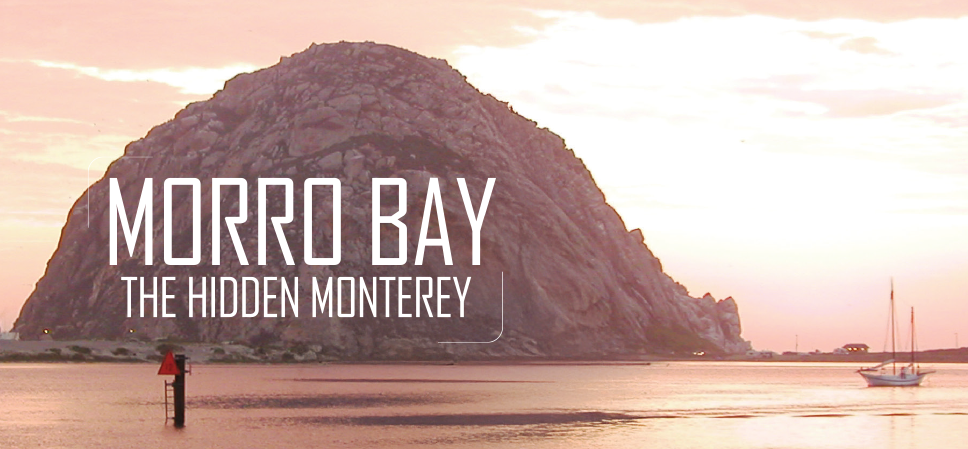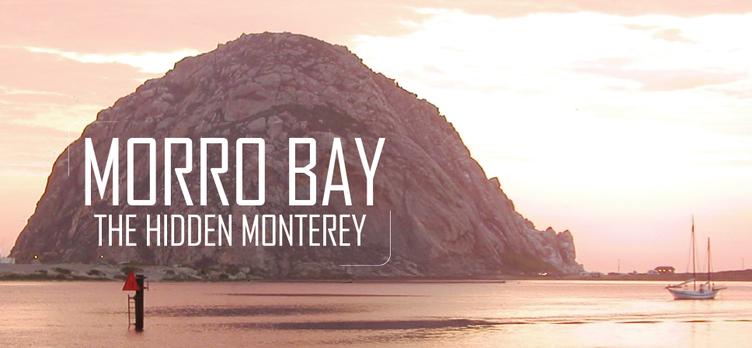It was our first real taste of the California coast line. Heading up Route 1 after having driven out from Boston, we came upon a huge rock—“the Rock” as we were informed by locals—towering over a picturesque town and a lovely beach where we took a short break and collected sand dollars. The image of that massive outcropping never left me, and I returned to explore this hidden gem.
Monterey, Laid Back
Morro Bay is located midway between San Francisco and Los Angeles, near the university town of San Luis Obispo. Its famous landmark, Morro Rock, was named by Spanish explorer Juan Rodriguez Cabrillo in 1542 as he was charting the coast. Cabrillo called the rock El Moro because it resembled the head of a Moor, a people from North Africa known for the turbans they wore. The town itself was founded in 1870 as a port for the export of dairy and ranch products.
Unlike many coastal towns which have become overly-gentrified and touristy, Morro Bay still has a sense of a working community, and a commercial fishing village with a large marina. People are pleasant, and move at a much more relaxed pace. It reminds me of Monterey—only more laid back. And there is simply a ton of things to do, no matter what your taste in activities (https://www.morrobay.org/). Helpful hint: wear very comfortable walking shoes; much of the town is set back in a hilly area.
From the Embarcadero, lined with specialty boutiques and restaurants, to “Old Town” (just three blocks away) with its antique shops and cafes, to bird and whale watching, to its restored 1772 mission, nature museum, galleries, surfing, hiking, an 18-hole championship golf course... the list goes on. And that doesn’t include the town’s proximity to two state parks, as well as other towns, beaches and points of interest.
The ‘Gibraltar of the Pacific’
Rising 576 feet into the air at the entrance of the harbor, the Rock is the last of the Nine Sisters, a series of volcanic plugs that stretch in a line inland to San Luis Obispo. Craggy and fissured by countless years of erosion, the Rock was actually partially quarried to create the protective breakwater and a connecting causeway to the mainland. Such activity was banned in 1969.
Fifty acres at the base, the Rock anchors the large harbor to the South and white sand beaches to the north. Designated as a state and national bird sanctuary, it’s home to the Peregrine Falcon, and serves host to myriad sea birds. As a result, climbing is prohibited, but you can walk around the base on pleasant walking trails.
By the way, if you’re wondering about those tall smoke stacks not far from the Rock – it’s a power plant from the 1950s built by Bechtel and PG&E to support the state’s rapidly-growing population at that time. It was decommissioned starting the late 1990s, and its future remains as yet undecided.
Eco-tourism
Morro Bay is an absolute paradise for those who love to get close to nature. We hiked Black Hill, the second of the volcanic plugs, taller than the Rock, and overlooking the whole area. And encountered a surprising phenomenon— the higher we went, the hotter it got. By the time we reached the top, Monterey cypress and flowering bushes had given way to chaparral, sage, and battling butterflies. The fogs and sea breezes don’t reach high enough to cool the taller hills.
Black Hill overlooks Chorro Creek, the bay’s largest tributary, which forms an estuary in the back bay between Morro Bay and the small town of Los Osos. Part of the bird sanctuary providing a safe habitat to more than two dozen threatened and endangered species. It’s the last estuary of its kind between Mexico and Northern California, and a major stop on the Pacific flyway. Over 70 migratory bird species make their winter home here.
The large lagoon of the bay is ideal for boating and kayaking, and many paddle over to the sand bar across the water to walk the beach, and enjoy the birds, wildlife and ocean views.
An excellent stop is the Museum of Natural History in Morro Bay State Park (https://www.parks.ca.gov/?page_id=31273 ), just south of the town. The museum offers activities for all ages: hands-on exhibits, nature walks, exhibits, lectures, puppet shows, videos, docent led tours and special events.
Whale watching and beaches
One thing we didn’t expect were whales. The large bay with its ample food source harbors whales year ‘round. Taking a trip on one of the local whale watch boats, we got up close and personal with several whales. And it wasn’t just tails—these leviathans surged out of the water to feed and we were sure that one humpback humorist was circling the boat. For nearly three hours, we delighted in these mammoth fellow tourists.
If you’re into beach walking, take a stroll along the curved north beach which goes along three miles of white sand. The further you get from the Rock, the less people, and soon it’s just you and the sand pipers, pelicans and sea gulls—with the occasional sea otter and seal—and the steady hiss-rumble of the waves. Keep an eye out for sand dollars and seashells of all sizes.
So much to do
The Embarcadero, which is located where the old wharf once was, it an enjoyable afternoon stroll of boutiques ranging from the touristy to very expensive, salt water taffy shops and plenty of places to eat at whatever price suits your wallet. No surprise, fresh seafood dominates the menus, and there are many restaurants that overlook the marina.
“Old Town,” to which you can walk from the Embarcadero, and replete with bookstores, antique stores, cafes, and eclectic shops. And for those into golf, Morro Bay features an 18-hole championship public golf course with stunning views of the bay.
We ran out of time, and didn’t get to see the rest of Morro Bay State Park, Heron Rookery Nature Preserved, Montaña de Oro State Park, the El Moro Elfin Forest and Audubon’s Sweet Springs Nature Preserve. Which means we’ll have to go back again — and we can’t wait!





